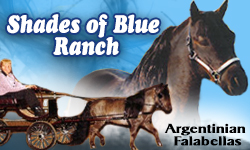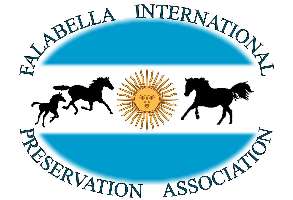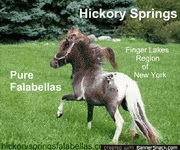|
History of the Falabella Minihorse Breed
By: Diane Wolcott
A Summary of ACCF Accounts
What is a FALABELLA Minihorse?
FALABELLA is a special and unique horse breed that has acquired, after many generations of selection and crossings, stable characteristics of build and height and is one of the smallest breeds of horse in the world. The name "FALABELLA" comes from the Argentine breeder's family, who developed the breed in the middle of the 19th Century (around 1845). This breed is extremely long-lived, often reaching 40-45 years old. The horses possess all the features and attributes of its taller relatives and the young are bred with the same temperament.
Credited as the "breeder of origin" for the Falabella breed, by 1853, Patrick Newtall had created a herd of small, perfectly built little horses of around 102cms. In 1879 he transferred his findings, herd, breeding methods and knowledge to his son-in-law, Juan Falabella. In 1905 the herd was transferred to the next generation, Emilio and in 1927 the establishment was inherited by Julio Cesar Falabella who kept careful genealogical records and is the most well known of the Falabella breeders. Beginning in the 1940s, Julio C. Falabella, created a formal breed registry, the Establecimientos Falabella, now the Asociación de Criadores de Caballos Falabella (ACCF-Falabella Horse Breeders Association).
A genuine Falabella horse is one that has a pedigree of uninterrupted bloodlines of animal stock originally bred by the Falabella family. Any horse that does not have a bloodline solely from those originally bred by and accredited to ESTABLICIMIENTOS FALABELLA Av., quintana 494 piso 6, A1129 BUENOS AIRES, ARGENTINIË is not a Falabella.
Today the Falabella is recognized as a Breed and known as the true original miniature horse.
The FALABELLAS are a horse breed
The FALABELLA is a horse, a special kind that has got every nature and attributes of its taller relatives.
The fixation of the Falabella genetic characters enable its natural reproduction, procreating beings of its same features and build. Differing from other kinds of miniature horses, most of which do not transmit their small size to their descendants, there takes part in Falabella gestation or rearing no kind of artifice to achieve its reduced size.
This achievement of genetic stability is what enabled its reproduction and worldwide renown. Only a long pedigree going back to imports from the Falabella Ranch on both sides can show that an animal is a genuine, pure Falabella. Some registries will 'parentage-qualify' via a DNA test if the pedigree is somehow not available. The DNA test can pick up 'non Falabella' markers in cases where it is impossible to parentage-qualify - for example if one parent has died. Today the numbers of pure bred animals are still few, but maintaining DNA records can ensure that these horses maintain the ideal standards that have been fixed through generations of breeding.
The Falabella is a horse that possesses all the features and attributes of its taller relatives. The fixed nature of the DNA genetic characteristics of the Falabella allows for their natural reproduction. Offspring are bred with the same temperament.
No horse can 'become' a Falabella if it is not pure bred and proven to be so by having either an official Argentinian breeding certificate or by being DNA tested, but Falabellas can 'become' other breeds such as American Miniatures. In fact it is probable that the American Miniature horse breed owes quite a lot to this breed for many great blood lines, it being only officially established in 1971. Many registered American Miniatures can in fact trace their ancestry back to Falabellas.
Characteristics of FALABELLAS
Beyond their minute size, the FALABELLAS show conditions of docility, strength and capacity to adapt higher than any other kind of similar horses and even than many of their bigger relatives. Strength tests made on them show them to be extremely strong--similar to draft and saddle horses of greater size.
Falabella miniature horses are true horses and not ponies, meaning that even the tiniest examples of the breed retain the structure and proportions of a full-size horse. The Falabella can be any number of types, from stock horse types that look like miniature American quarter horses to the sleeker Arabian types.
Unique Features: Unlike other horse breeds, the Falabella has seventeen vertebrae instead of eighteen, and one less pair of ribs. Senor Julio C. Falabella (1912-1980), also discovered that his FALABELLA horses--no matter what their size--had a heart the same size as the heart of a normally-sized horse. He believed that this was one of the reasons why FALABELLA horses live longer than the average horse, and they remain in a good state of health until the end. Julio Falabella is quoted as saying, "My little horses are in their prime when they are twenty and they live to become 42, still having all their teeth and not looking at all sickly and pitiful".
An unusual feature of the FALABELLA is the gestation period. This can range two months longer than for most horses--close to 13 months. Many of the foals are tiny -- ranging in size from 16-17 inches (41-43 cm height) but they grow very quickly in their first year.
The disposition of the Falabella is quite notable, they are very friendly, extremely gentle and very intelligent. They make great performance horses and can be easily trained as driving horses, show horses, or trick horses.
The Falabella has fine, silky hair and skin that is thin and supple. The hooves are narrow with an oval shape. Some manes are short and straight while others are long and falling on both sides of the neck. The gait is spontaneous and very energetic. The most common colors for the horse are black or brown but may vary from pinto, bay and chestnut, and the most loved by Senor Falabella, the appaloosa.
How tall is a Falabella?
The standard height for an animal of controlled production at the Argentine farm is seldom taller than eight hands (78cm/32") in height at the withers. For breed and nurse animals -- of certified reproductive capacity -- it varies for each category from 70 cm or less to 80 cm, all of them having the same genetic characters that enable them to be reproducers of specimens of their same kind and build, even of a lower height. JUANCITO 168 FALABELLA stallion (67 cm height) is a son of FALABELLA RONCO 32 (71 cm height) and of FALABELLA MARGOT 89 (80 cm height). Obviously, the reproductive capacity of the parents takes part in the product result. The Argentine farm has kept a record and control of each breeding animal included in their nursing groups.
The size of the Falabella horse varies but the smallest varieties always are highly prized. Small size alone, however, does not make a quality Falabella horse. Rather, it is the combination of small stature and correct conformation that sets the breeding quality Falabella apart and helps to perpetuate the health and vitality of this unique breed.
The Argentine Establishment continues working on genetic investigation to achieve specimens which are smaller each time. They have actually attained adult specimens less than 50 cm (20 inches) in height. However, the principal object of the breeding plan is centered on obtaining specific characteristics, each time more uniform, with an average height of approximately 70 cm (27.5 inches) in height.
How a FALABELLA lives
For centuries the FALABELLA has lived in a natural condition over the vast plains ("pampas"), in Argentina. The horses were forced to move great distances to find water and pasture due to the strong sun, cold southwestern winds ("El Pampero"), fierce storms and aridity of the land. This gave them incomparable resistance. Their keen instincts and ability to sense danger were sharpened by this rustic environment.
On the Falabella Farm in Buenos Aires, Argentina, the horses live naturally in meadows without the aid of artificial climate, to maintain their rustic characteristics. This permits sending them to the most diverse climates and assuring their survival. The climate in Buenos Aires is quite variable, dropping in the winter to below 0 degrees and in the summer above 87 degrees.
Due to their natural rusticity and immense ability to adapt to severe weather conditions, FALABELLA horses do not require much care other than that advisable for any other horse. They practically do not need the aid of any veterinary treatment, and their feeding is very simple and they do not require any special feeding treatment.
Senor Falabella maintained two ranches in Argentina -- La Francesa, 12,000 acres in Azul, and a smaller ranch -- Recreo de Roca 1,000 acres -- a short distance from Buenos Aires. In recent years since the death of Maria Luisa de Falabella in 2007 the Falabella horses have been moved to the family's 8000 hectare (19,768 acre) ranch some 1000 kms north of Buenos Aires. There is also a 45 hectare area (11 acres) close to the capital where the horses for sale are taken and to which visitors are given access.
Famous FALABELLAS Moments in the History of the Breed
In 1845, Mr Patrick Newtall, on the Argentine meadowlands--to the south of Buenos Aires -- the tribes of Pampas Indians had, among their horses, some unusually small ones that caught his attention, and he managed to collect a few specimens from the Indians.
In 1853, after ,many years of experiments and selections, has been successful in creating a herd of perfectly built horses, characterized by a nature of their own, lower than one meter height.
In 1879, his son-in-law, Mr. Juan Falabella, joins in the family investigations and Newtall transmits to him all his findings and knowledge of his breeding.
In 1893, Mr. Juan Falabella, through successive crossings, gradually builds the first miniature horses, of harmonious shape and heights lower than 85 cms.
In 1905, Juan Falabella transmits the rearing of this new breed --already known as FALABELLA--to his son, Emilio, who proceeds with the reproduction of inherited horses and, through a strict selection, manages to establish the build pattern known at present.
In 1927, Senor Julio Cesar Falabella, takes on the Establishments, inheriting from his ancestors not only breeding horses, but also the wisdom and knowledge, through several generations, of the breed FALABELLA. He being responsible for the systematization of the breed, and begins the creation of genealogic records for the breed.
In 1937 is born NAPOLEON I, a chestnut colored-piebald horse that would give one of the best sang lines to the Establishments, many of the descendants of which are now registered as part of the origins of miniature horses now living around the world. A favorite of the Falabella family, short and stocky Napoleon, who matured at only 27 inches and weighed one hundred pounds, lived to a ripe old age of 42 and upon his death, a monument was erected in his honor on the Falabella Ranch. At the time of his death, he was claimed to be the oldest living horse in the world.
In 1950, through the promotion of his miniature horses, Julio Falabella promotes interests in his breed, and many horse breeders and amateurs are prompted to seek raising them in different parts of the world. FALABELLA horses are studied from Europe, America and the Far East.
In 1962, The Regina Winery in California, owned by John B and Frank Elena, imported the first 12 FALABELLA horses to the United States from the Falabella Ranch in Argentina. The horses became a great attraction at the Winery, and were known as the FALABELLA Lilliputian Miniature Horses. One of these horses was the famous appaloosa CHIANTI. This magnificent leopard appaloosa stallion became one of the most famous appaloosa stallions in the country; and his name appears in the pedigrees of many miniature horses today.
In 1968 is born JAUNCITO 168 FALABELLA, a chestnut horse that was included in the breed nursery, and was of the "sang" line which is one of the main lines within the Falabella Establishments.
In 1973, together with his second wife, Maria L.B. Falabella, Julio Cesar systematizes the breed pattern, establishing the records that now regulate the reproduction of this breed.
In 1977, Julio Falabella, who especially liked the loud coloured horses with many of his herd descendants today appaloosa and pinto, agrees to sell one of his favorites, an appaloosa stallion named Menelek. Sold to Lord and Lady Fisher of England in 1977, imported to England he was the foundation used to start a Falabella bloodline in the United Kingdom. The Kilverstone Zoo was established to promote the breed. Menelek was one of the most prolific sires of Falabella Miniature Horses in England, and Europe. With great regret, Menelek, met his untimely death, as the direct result of an irate mare's violent kick.
In 1980, Senor Julio Cesar Falabella dies, and his wife, Maria Luisa B. de Falabella and his only true heir, daughter, Maria Angelica Falabella begin the long process of settling the Falabella estate. Maria Luisa and her 3 sons from a previous marriage, take on the Falabella Establishments, as Argentine law sways toward the wife getting most everything in an estate. Julio's daughter, Angelica, had a farm outside Buenos Aires, and was given rights to about half of the original Falabella herd. As the only true blood heir, she is the true owner and successor of generations of breeders of this unique miniature horse.
In 1990, the shared interests of a group of Falabella breeders pursuing common goals resulted in the creation of the Falabella Horse Breeders Association, Association of Equine Development-with honorary member status- and by the Argentine Undersecretary of Agriculture. Livestock and Fishing. Under the honorary Presidency of Maria Luisa Falabella, the Association has authorities of other nations and foreign horse breeding associations.
In the early 1990's, Maria Angelica Falabella came to the US, and with her partner, Washington Sea, began a Falabella ranch, Falabella AF Farm, in South Carolina. Horses purchased from Angelica Falabella and "hard-shipped" into the American registries--AMHA and AMHR...were often registered with the Falabella AF name. Any that were imported from Angelica's ranch in Argentina -- Rancho Falabella Caballos Miniatura -- carried the Falabella name with the AF in it. In the early 1990's, when Angelica came to the USA her horses were switched to using just the AF prefix. The FMHA (Falabella Miniature Horse Association--Registry for Falabella Horses) began using Angelica's rightful Falabella name in registering her horses in 2001. The "FALABELLA AF" horses are Angelica's. The Falabella prefix horses are from "her" Argentina farm, Rancho Falabella Caballos Miniatura.
Training and Showing a Falabella Horse Today:
Being of an exceptionally docile friendly nature, yet also spirited, these tiny horses respond to training amazingly fast and well. They are generally considered to be above average in intelligence. They can be ridden by children up to about 8 years of age, and can be driven with small carts. Senior Falabella kept 20-30 horses at his Recreo de Roca ranch, where their deportment both inside and out side the house was exemplary--dignified and obedient. Trained horses can take all gaits on command, and they enjoy jumping three feet and higher for the sheer joy of it. There is no question that a FALABELLA can be taught to perform feats that would do justice to the best trained liberty horse or other horse of larger breeds.
As an exotic pet, Falabellas are not easily available worldwide. A quick witted horse, Falabellas are known to perform well. It is said that an owner can teach his horse to shake hands and perform other tricks within few hours time.
In 2009, at age 13, a pure Argentine-line Falabella, a beautiful black leopard stallion, Taquito, became one of the most celebrated Falabella show horses in the US. Taquito, owned by Mini Miracles Farms, is the 2009 AMHA World Champion Multi-colored Stallion and an AMHA World Top Ten Horse in Gentlemen Country Pleasure Driving. This exceptional Falabella stallion is bringing the FALABELLA breed to the forefront of the American miniature horse registries.
|



